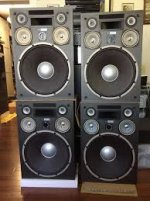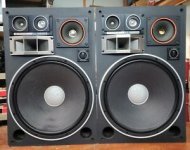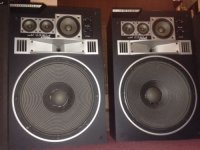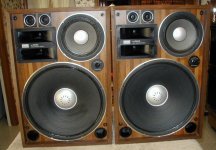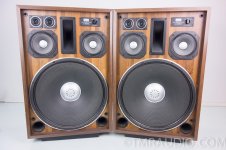Things dont shaffle around enough with 6" 8" you actually need 12" or 15" to do so . Similarl hor highs. 1 inch is enough . And for mids to stop them from getting coloured with white noice from tweeter and over exertion from low frequencies a seperate mid is important. So three way is minimum. Unless you need a system to just to understand the words . In which case 1 fullrange with high effeciency is enough . I have driven a 99db driver with 1 w amp that can get loud enough to shatter the eardrums
Many hi-end speakers use say 8" woofers, just multiples ones, with higher excursion and good suspensions and motors, to create sufficient bass for most listeners. You wind up with a narrower cabinet (better for diffraction) and better transient response (the physics of "overhang" haven't gone away with large drivers). And bass drivers IMO shouldn't be allowed to get very far into any midrange, so low xover point. So the deep bass is below 100 Hz (really 60-80Hz), dealing with a 15" say for that low range seems very old fashioned when there are alternatives. What didn't exist back in the heyday of large woofers were smaller high-excursion drivers that can now physically move the air required. Agree 3-way with terrific driver selection and xovers integrated has many advantage's. But for near field listening, a good 2-way main speaker can do the trick, with a sub (so that's really a 3-way anyway, just a different design approach than the older fashioned huge woofer, say 6 inch mid, and tweeter).
@skfisher
I think i disagree with everything here
sounds like a bunch of mashed up confused ideas put together
I think i disagree with everything here
sounds like a bunch of mashed up confused ideas put together
Well one of the reasons there have been so many variations in speaker design over the past 50-60 years (and still are) is there hasn't been universal agreement on several key aspects of design. So there are the big woofer lovers, and there are multiple smaller bass driver lovers, sub lovers, etc. And dome mids vs. cone mids, the list goes on.
I have used 12" and 15" woofers in designs in the 1970s using 3 cu. ft. enclosures, more recently have enjoyed designs that can produce good, smooth bass to 40 Hz with smaller drivers and enclosures. As we know the sub was developed to get good bass from smaller enclosures, and so the main speakers don't have to be that big. The OP posited that good 2-way designs mean 3-ways may be not be needed. I would make the case that the main speakers can certainly be good 2-ways, and a sub can provide the low bass if you want down to 20 Hz.
I think transistor amps are fine by the way 🙂
I think transistor amps are fine by the way 🙂
It also effect weather you use active or passive crossover. Active crossover save amplifier bandwith. Anything hifi should always go with active crossover.
Increasing the number of ways may decrease IMD but may also increase other issues.
Drivers in separate boxes that are mechanically isolated from each other seems like a rare luxury. Woofers are often off-centre, resulting in vibrations that not only move the box (which could be benign if it's pure dipole motion) but actually rotate the box around its centre of mass. These forces get transferred to whatever else is connected.
Similarly with leakage of magnetic fields. Out-of-band signals are surely measureable across speaker terminals. Whether generated by air vibrations or box vibrations, the drivers will interact with each other, but it's rare to see additional effort to try and cancel or correct for that crosstalk.
Drivers in separate boxes that are mechanically isolated from each other seems like a rare luxury. Woofers are often off-centre, resulting in vibrations that not only move the box (which could be benign if it's pure dipole motion) but actually rotate the box around its centre of mass. These forces get transferred to whatever else is connected.
Similarly with leakage of magnetic fields. Out-of-band signals are surely measureable across speaker terminals. Whether generated by air vibrations or box vibrations, the drivers will interact with each other, but it's rare to see additional effort to try and cancel or correct for that crosstalk.
why?Anything hifi should always go with active crossover.
Yeah, I'm not in that camp either.why?
Because he said so?
Passive or active, both can lead to great sound. It all depends on execution.
Passive or active, both can lead to great sound. It all depends on execution.
I can provide many claims too...
No 2way will ever compete with well executed 3way.
Best 3way is 4way.
See, its so easy, we should all come up with useless claims.
No 2way will ever compete with well executed 3way.
Best 3way is 4way.
See, its so easy, we should all come up with useless claims.
Many would agree with you Adison and these days I think it is simply cheaper and easier to use electronics or DSP for the crossovers, and especially if we are talking about passive crossovers in the very low bass area.
My Behringer cost less than a pair of low DCR inductors to set a bass XO at 80Hz so frugality is important as well as sound quality
My Behringer cost less than a pair of low DCR inductors to set a bass XO at 80Hz so frugality is important as well as sound quality
Totally agree adason . I think people have great imaginations on this forum and get side tracked with all sorts of opions and biases.
My opinion (or bias) is that the approach and design chosen should be based on the key objective(s) and also constraints of the listener. If a key objective is good overall sound at an affordable price and in a smaller room (the cost and space constraint) there are many good smaller 2-ways that can do that. If a key objective is listening to jazz with lots of brass then a 3-way may be the better choice with a dedicated mid. If one likes pulsating bass and has a somewhat larger room with placement flexibility, subs added to 2 and 3 way designs can be a plus. Someone older with reduced high frequency hearing may enjoy certain types of tweeters over others. Someone with a really bad listening room (but that's all that available) may want speakers than minimize reflected sound. Could cite many examples. These bigger picture considerations should come before getting into the design details. There are many solutions available.
exactlyTotally agree adason . I think people have great imaginations on this forum and get side tracked with all sorts of opions and biases.
less talk, more build is what diyaudio needs
lots and lots of talkers here, very few who actually build stuff.
4 wayI can provide many claims too...
No 2way will ever compete with well executed 3way.
Best 3way is 4way.
See, its so easy, we should all come up with useless claims.
pffft
5 way only, and active, otherwise, your not even close to hifi
When i converted my 4way to 4.5way, it was big improvement. I am not kidding, but for totally different reason 🙂
Its all here:
https://www.diyaudio.com/community/threads/viral-projects-sort-of.351475/post-7109810
Its all here:
https://www.diyaudio.com/community/threads/viral-projects-sort-of.351475/post-7109810
At this point I am only interested in 10-way speakers. I just can't listen to a 9-way, or (gag) a mere 8-way. Imagine asking a driver to cover more than a single octave... why it is just outrageous. A 3-way (eye roll) is not hi-fi... it is not low-fi... it is No-Fi... I had this amp specially made, it goes to 11.
Good old times of kabuki speakers...
Btw, the premise of this thread is there are great sounding cheap 2way speakers out there. I am still waiting for op to tell me what they are and where to get them.
Btw, the premise of this thread is there are great sounding cheap 2way speakers out there. I am still waiting for op to tell me what they are and where to get them.
Attachments
In lots of ways designs have moved on a long way since then. I was also designing in the early 80s with large drivers and none of them would hold a candle to current ones. I also disagree with most of your earlier post, for example, narrower baffles have a higher baffle step which compromises LF performance, and need not affect MF/HF design.I have used 12" and 15" woofers in designs in the 1970s using 3 cu. ft. enclosures
I have never, ever, heard a narrow enclosure that sounded real and tactile in the way wider ones with larger drivers do.
- Home
- Loudspeakers
- Multi-Way
- There are great sounding and not super expensive 2-way designs. Why go for 3-way, then?
